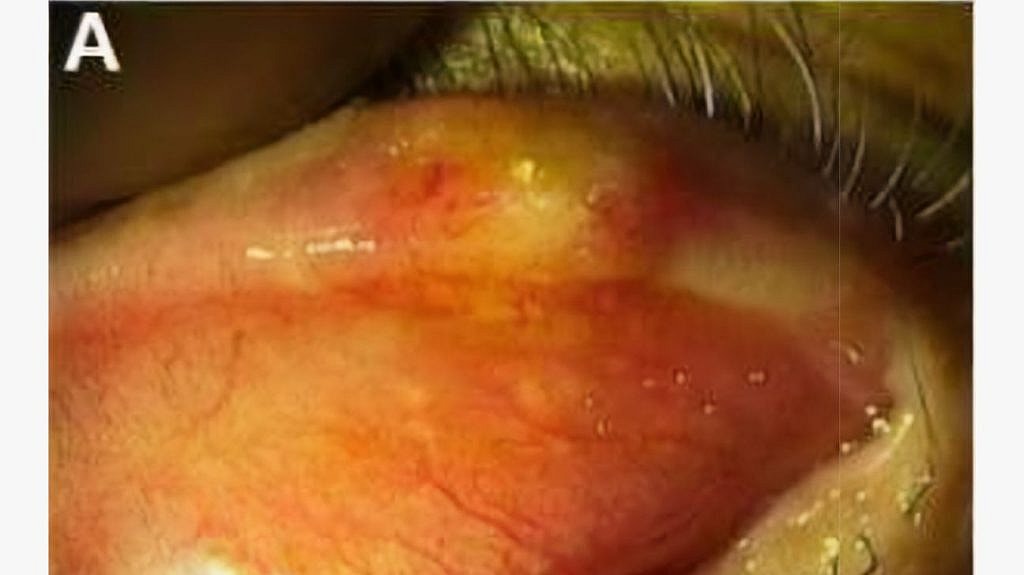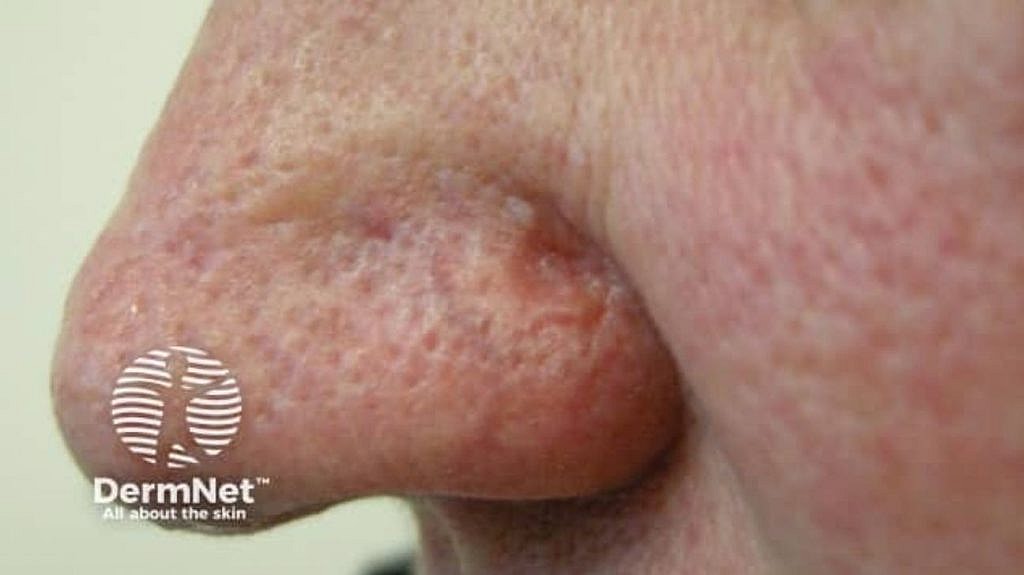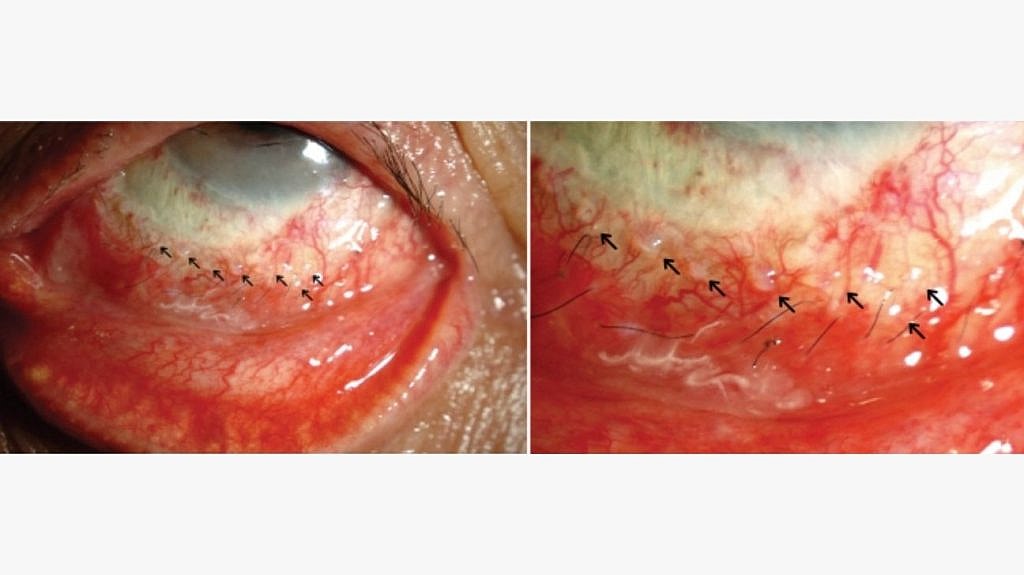Sebaceous Carcinoma: Symptoms, Photos, Staging, Treatment
Sebaceous carcinoma is a rare but aggressive skin cancer that often affects the eyelids but can develop in any sebaceous gland in your body.
More than 95% of nonmelanoma skin cancers are either basal cell or squamous cell carcinomas. While these cancer types are common, their survival rates are extremely high.
But there are other, rarer types of nonmelanoma skin cancer, and they don’t always have as favorable an outlook.
In this article, we discuss sebaceous carcinoma, a rare but more aggressive skin cancer that develops in your sebaceous glands. It’s often challenging to diagnose, which can sometimes lead to delayed treatment. We review who’s at risk, how to spot it, and what to expect for treatment options and long-term outlook.
What are sebaceous glands?
Sebaceous glands produce sebum, an oily substance that keeps your skin moist and protects it from ultraviolet radiation. They develop alongside hair follicles, so they’re found anywhere on your body where there’s hair. But most are on your face and scalp.
What are the symptoms of sebaceous carcinoma?
Most sebaceous carcinomas develop on the eyelid. They can develop on the upper or lower eyelid, but they most commonly appear on the upper eyelid, where more glands are present.
You might notice a small painless bump or pimple forming on your eyelid or a thickening of your eyelid at the lash line.
Other symptoms can include:
What does sebaceous carcinoma look like?
A sebaceous carcinoma may look relatively benign when you first spot it. It often appears in the eye area as a small, firm, painless lump. Some people even mistake it for pink eye, a stye, or a chalazion.
Sebaceous carcinoma can also develop on other parts of the body, such as the:
When it develops in these areas, it might start as a small pink or yellowish growth or a mole. It may begin to grow or change as time passes.
Photos of sebaceous carcinoma

Sebaceous carcinoma most commonly appears as a yellowish mass in the upper eyelid. (Copyright © 2014 Nemoto et al. This work is published by Dove Medical Press Limited, CC BY-NC 3.0)

Sebaceous carcinoma can also develop in other areas, especially the face. (Photo by DermNet New Zealand 2024)

Sebaceous carcinoma has a high chance of spreading, including to the eye socket or other more distant tissues or organs. (Copyright © 2009 by the Korean Ophthalmological Society CC BY-NC 3.0)
What causes sebaceous carcinoma?
Like all cancers, sebaceous carcinomas occur due to genetic mutations that cause healthy cells to become cancerous. In the case of sebaceous carcinomas, the affected cells are in the sebaceous glands. According to a 2021 research review, multiple genes are involved.
Scientists aren’t entirely sure what causes the mutations, but they have a few ideas. Environmental factors, like ultraviolet (UV) radiation, may play a role.
Who is at risk of sebaceous carcinoma?
Though rare, sebaceous carcinomas are becoming more common.
Studies in England and the United States found that sebaceous carcinomas were more common in males than females and most common in white people.
But in Asian countries like China, India, and Korea, where sebaceous carcinomas make up a larger portion of eyelid cancers, studies show a higher prevalence in females.
Although there are rare cases of sebaceous carcinomas in children, it typically affects adults over age 40 years, mostly affecting those ages 60 to 80 years.
Other known risk factors include:
How do doctors diagnose sebaceous carcinoma?
Although a primary care physician may suspect a sebaceous carcinoma, they will likely refer you to a specialist, such as an ophthalmologist or dermatologist.
The doctor will likely start by requesting your medical history. If you know that you have risk factors, let them know.
The doctor will then perform a skin exam and examine your lymph nodes. They may also want to schedule a skin biopsy to examine the cells under a microscope.
What are the stages of sebaceous carcinoma?
If a doctor confirms this cancer diagnosis early, it may still be localized. The specific staging can depend on whether the carcinoma is on the eyelid or another body part.
The American Joint Committee on Cancer uses a T staging system for eyelid cancers. This system evaluates the size of the tumor and its spread.
| Stage | Description |
|---|---|
| TX or T0 or Tis | There’s no evidence of a tumor or what look like cancerous cells have not yet spread beyond their original site (in situ). |
| T1 | The tumor is 10 mm or less. |
| T2 | The tumor is 20 mm or less but more than 10 mm. |
| T3 | The tumor is 30 mm or less but more than 20 mm. |
| T4 | The tumor has invaded nearby structures like the eye socket or face. |
For sebaceous carcinomas that do not form on the eyelids, doctors use the AJCC’s nonmelanoma TNM staging system. It also has five stages (0 to 4), with higher stages representing more significant spread.
Experts recommend that doctors check for lymph node involvement or other evidence that the cancer may have spread beyond its localized site as soon as possible.
What is the treatment for sebaceous carcinoma?
The recommended first-line treatment for sebaceous carcinoma is surgery to remove it. Possible surgical options include excision and Mohs surgery, a type of specialized surgery used to treat some skin cancers.
Radiation therapy may be a better choice if you cannot have surgery or if the cancer has spread to your lymph nodes.
If cancer has spread to the conjunctiva (the protective membrane of your eye), a doctor may also recommend mitomycin C cream or cryotherapy.
In rare cases where cancer has spread significantly into the eye, you may require surgery to remove the eyeball and surrounding tissue.
What is the outlook for people with sebaceous carcinoma?
Sebaceous carcinoma is more aggressive than other, more common nonmelanoma skin cancers. Still, with early diagnosis and treatment, people with sebaceous carcinoma can improve their chances of a favorable outcome.
The 5-year relative survival rate for people with localized sebaceous carcinoma is 78%. That drops to about 50% if the disease has spread.
Since this type of cancer is aggressive and often returns, your doctor will want to monitor you closely after undergoing treatment and require frequent checks for at least 3 years.
Frequently Asked Questions About Sebaceous Carcinoma
What is sebaceous carcinoma?
Sebaceous carcinoma is a rare but aggressive skin cancer that develops in the sebaceous glands. These glands are responsible for producing sebum, an oily substance that keeps your skin moist and protected from UV radiation.
What are the symptoms of sebaceous carcinoma?
Symptoms of sebaceous carcinoma often include a small, painless bump or pimple on the eyelid, thickening of the eyelid at the lash line, formation of a red or yellow crust, growths that bleed, or sores that do not heal.
How is sebaceous carcinoma diagnosed?
Diagnosis typically involves a referral to a specialist, who will review your medical history, perform a skin exam, check lymph nodes, and possibly conduct a skin biopsy to examine the cells under a microscope.
What causes sebaceous carcinoma?
Sebaceous carcinoma occurs due to genetic mutations that cause healthy cells in the sebaceous glands to become cancerous. Environmental factors like UV radiation may also contribute.
What are the risk factors for sebaceous carcinoma?
Risk factors include exposure to UV radiation, having Muir-Torre syndrome, a weakened immune system, and being over the age of 40. It is more common in males in Western countries and females in some Asian countries.
What are the stages of sebaceous carcinoma?
Sebaceous carcinoma staging depends on its location. The AJCC uses a T staging system for eyelid cancers and a TNM system for other body parts. Stages range from T0 (no tumor) to T4 (tumor has invaded nearby structures).
What are the treatment options for sebaceous carcinoma?
The primary treatment is surgery, including excision and Mohs surgery. Radiation therapy may be used if surgery is not possible or if the cancer has spread. Other treatments include mitomycin C cream, cryotherapy, and in severe cases, surgery to remove the eyeball and surrounding tissue.
What is the prognosis for sebaceous carcinoma?
Early diagnosis and treatment can improve outcomes. The 5-year relative survival rate is 78% for localized cases, but it drops to about 50% if the cancer has spread. Close monitoring post-treatment is crucial due to the aggressive nature of the cancer.
How serious is sebaceous carcinoma?
Sebaceous carcinoma is highly aggressive and can be fatal if it spreads. Early diagnosis and prompt treatment are essential for a better prognosis.
Where does sebaceous carcinoma metastasize?
Sebaceous carcinoma can spread to lymph nodes, bones, liver, or lungs.
What syndrome is associated with sebaceous carcinoma?
Muir-Torre syndrome, a rare genetic condition, is associated with an increased risk of sebaceous carcinoma and other types of tumors, including colorectal, endometrial, and ovarian cancers.
How serious is sebaceous carcinoma?
Sebaceous carcinoma tends to be aggressive and has a high chance of spreading. The American Academy of Dermatology Association (AAD) cautions that it can be fatal if it spreads. The sooner doctors confirm a diagnosis and treat it, the better.
Where does sebaceous carcinoma metastasize?
Sebaceous carcinoma can spread almost anywhere, including your lymph nodes, bones, liver, or lungs.
What syndrome is associated with sebaceous carcinoma?
Research links Muir-Torre syndrome (MTS), a rare genetic condition, with sebaceous carcinoma. In fact, MTS has links to an increased risk of several different kinds of tumors, including colorectal, endometrial, and ovarian cancers.
Takeaway
Most people with skin cancer develop basal cell or squamous cell carcinoma. But the rare sebaceous carcinoma can be more aggressive than these more common types.
If you develop a new skin growth, ask a doctor to evaluate it. It may be nothing, but if it’s sebaceous carcinoma, you’ll want to get treatment immediately to help ensure the best possible outcome.








Thank you for providing such a comprehensive overview of sebaceous carcinoma. It’s crucial to raise awareness of this rare type of cancer, as early detection can significantly impact treatment outcomes. The inclusion of symptoms and staging information helps readers understand the importance of seeking medical advice promptly. The photos are particularly useful for identifying potential signs. Keep up the great work in educating others!
Thank you for sharing such a comprehensive post on sebaceous carcinoma. The detailed explanation of symptoms and stages is incredibly informative, and the inclusion of photos helps in understanding what to look for. The section on treatment options is especially helpful for those seeking guidance on how to manage this condition. It’s a great resource for both patients and caregivers looking to learn more about this rare type of cancer.
Thank you for sharing this comprehensive post on sebaceous carcinoma. It’s crucial to raise awareness about this rare form of cancer, and your inclusion of symptoms, photos, staging, and treatment options is incredibly informative. This can be a valuable resource for anyone looking to understand more about the condition and what to look out for. Keep up the great work in educating and informing the community!
Thank you for this comprehensive post on sebaceous carcinoma. It’s important to raise awareness about this rare skin cancer. Including photos and information on symptoms and staging helps in early detection, which is crucial for successful treatment. I appreciate the detailed explanation of treatment options as well. It’s a valuable resource for anyone wanting to learn more about this condition. Keep up the great work in educating others!
Thank you for the informative post on sebaceous carcinoma. It’s crucial to spread awareness about this rare form of cancer, as early detection can significantly impact outcomes. The breakdown of symptoms, along with the photos, really helps in understanding what to look out for. Additionally, the information on staging and treatment options is valuable for anyone seeking to understand their diagnosis or support a loved one. Keep up the great work in educating us on important health matters!
Thank you for sharing this informative post on sebaceous carcinoma. It’s crucial to raise awareness about this rare but serious skin cancer. The detailed information on symptoms and treatment options can really help individuals understand and identify any warning signs early on. The inclusion of photos and staging explanations also provides a clearer understanding of what to look out for. Great work on this comprehensive guide!
This is an incredibly informative post! Sebaceous carcinoma is such a rare condition, and it’s important for people to be aware of its symptoms and treatment options. The inclusion of photos is particularly helpful for those of us trying to understand what to look out for. Thank you for providing such a comprehensive resource on this topic.
This post provides a comprehensive overview of sebaceous carcinoma, serving as a valuable resource for understanding this rare skin cancer. The details about symptoms, staging, and treatment options are well-explained, helping readers grasp the seriousness of the condition and the importance of early detection. Additionally, including photos is particularly helpful for visual identification. Great job in raising awareness and equipping readers with crucial information!